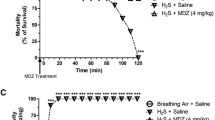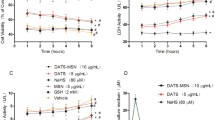Abstract
Hydrogen sulfide (H2S) intoxication produces a rapid cardio-circulatory failure leading to cardiac arrest. In non-lethal forms of sulfide exposure, the presence of a circulatory shock is associated with long-term neurological sequelae. Our aim was to clarify the mechanisms of H2S-induced circulatory failure. In anesthetized, paralyzed, and mechanically ventilated rats, cardiac output, arterial pressure and ventricular pressures were determined while NaHS was infused to increase arterial concentration of soluble H2S (CgH2S) from undetectable to levels leading to circulatory failure. Compared to control/saline infusion, blood pressure started to decrease significantly along with a modest drop in peripheral vascular resistance (−19 ± 5 %, P < 0.01), when CgH2S reached about 1 μM. As CgH2S exceeded 2–3 μM, parameters of ventricular contractility diminished with no further reduction in peripheral resistance. Whenever H2S exposure was maintained at a higher level (CgH2S over 7 μM), a severe depression of cardiac contractility was observed, leading to asystole within minutes, but with no evidence of peripheral vasoplegia. The immediate and long-term neurological effects of specifically counteracting sulfide-induced cardiac contractility depression following H2S exposure remain to be investigated.









Similar content being viewed by others
References
Reiffenstein, R. J., Hulbert, W. C., & Roth, S. H. (1992). Toxicology of hydrogen sulfide. Annual Review of Pharmacology and Toxicology, 32, 109–134.
Arnold, I. M., Dufresne, R. M., Alleyne, B. C., & Stuart, P. J. (1985). Health implication of occupational exposures to hydrogen sulfide. Journal of Occupational and Environmental Medicine, 27, 373–376.
Bott, E., & Dodd, M. (2013). Suicide by hydrogen sulfide inhalation. American Journal of Forensic Medicine and Pathology, 34, 23–25.
Tvedt, B., Skyberg, K., Aaserud, O., Hobbesland, A., & Mathiesen, T. (1991). Brain damage caused by hydrogen sulfide: A follow-up study of six patients. American Journal of Industrial Medicine, 20, 91–101.
Baldelli, R. J., Green, F. H., & Auer, R. N. (1993). Sulfide toxicity: Mechanical ventilation and hypotension determine survival rate and brain necrosis. Journal of Applied Physiology, 75, 1348–1353.
Yang, G., Wu, L., Jiang, B., Yang, W., Qi, J., Cao, K., et al. (2008). H2S as a physiologic vasorelaxant: Hypertension in mice with deletion of cystathionine gamma-lyase. Science, 322, 587–590.
Zhao, W., Zhang, J., Lu, Y., & Wang, R. (2001). The vasorelaxant effect of H(2)S as a novel endogenous gaseous K(ATP) channel opener. EMBO Journal, 20, 6008–6016.
Hosoki, R., Matsuki, N., & Kimura, H. (1997). The possible role of hydrogen sulfide as an endogenous smooth muscle relaxant in synergy with nitric oxide. Biochemical and Biophysical Research Communications, 237, 527–531.
Klingerman, C. M., Trushin, N., Prokopczyk, B., & Haouzi, P. (2013). H2S concentrations in the arterial blood during H2S administration in relation to its toxicity and effects on breathing. American Journal of Physiology: Regulatory, Integrative and Comparative Physiology, 305, R630–R638.
Haouzi, P., Sonobe, T., Torsell-Tubbs, N., Prokopczyk, B., Chenuel, B., & Klingerman, C. M. (2014). In vivo interactions between cobalt or ferric compounds and the pools of sulphide in the blood during and after H2S poisoning. Toxicological Sciences, 141, 493–504.
Zhang, R., Sun, Y., Tsai, H., Tang, C., Jin, H., & Du, J. (2012). Hydrogen sulfide inhibits L-type calcium currents depending upon the protein sulfhydryl state in rat cardiomyocytes. PLoS One, 7, e37073.
Sun, Y. G., Cao, Y. X., Wang, W. W., Ma, S. F., Yao, T., & Zhu, Y. C. (2008). Hydrogen sulphide is an inhibitor of L-type calcium channels and mechanical contraction in rat cardiomyocytes. Cardiovascular Research, 79, 632–641.
Olson, K. R. (2009). Is hydrogen sulfide a circulating “gasotransmitter” in vertebrate blood? Biochimica et Biophysica Acta, 1787, 856–863.
Olson, K. R. (2012). A practical look at the chemistry and biology of hydrogen sulfide. Antioxidants & Redox Signaling, 17, 32–44.
Szabo, C. (2007). Hydrogen sulphide and its therapeutic potential. Nature Reviews Drug Discovery, 6, 917–935.
Millero, F. J. (1986). The thermodynamics and kinetics of the hydrogen-sulfide system in natural-waters. Marine Chemistry, 18, 121–147.
Tang, G., Wu, L., Liang, W., & Wang, R. (2005). Direct stimulation of K(ATP) channels by exogenous and endogenous hydrogen sulfide in vascular smooth muscle cells. Molecular Pharmacology, 68, 1757–1764.
Coletta, C., Papapetropoulos, A., Erdelyi, K., Olah, G., Modis, K., Panopoulos, P., et al. (2012). Hydrogen sulfide and nitric oxide are mutually dependent in the regulation of angiogenesis and endothelium-dependent vasorelaxation. Proceedings of the National Academy of Sciences of the United States of America, 109, 9161–9166.
Bucci, M., Papapetropoulos, A., Vellecco, V., Zhou, Z., Zaid, A., Giannogonas, P., et al. (2012). CGMP-dependent protein kinase contributes to hydrogen sulfide-stimulated vasorelaxation. PLoS One, 7, e53319.
Timmers, H. J., Rongen, G. A., Karemaker, J. M., Wieling, W., Marres, H. A., & Lenders, J. W. (2004). The role of carotid chemoreceptors in the sympathetic activation by adenosine in humans. Clinical Science, 106, 75–82.
Marshall, J. M. (1994). Peripheral chemoreceptors and cardiovascular regulation. Physiological Reviews, 74, 543–594.
Winder, C. V., & Winder, H. O. (1933). The seat of action of sulfide on pulmonary ventilation. American Journal of Physiology, 105, 337–352.
Haouzi, P. (2012). Ventilatory and metabolic effects of exogenous hydrogen sulfide. Respiratory Physiology & Neurobiology, 184, 170–177.
Abboud, F. M., & Thames, M. D. (2011). Interaction of cardiovascular reflexes in circulatory control. Comprehensive Physiology, Supplement 8, 675–753.
Ariyaratnam, P., Loubani, M., & Morice, A. H. (2013). Hydrogen sulphide vasodilates human pulmonary arteries: A possible role in pulmonary hypertension? Microvascular Research, 90, 135–137.
Sun, Y., Tang, C. S., Jin, H. F., & Du, J. B. (2011). The vasorelaxing effect of hydrogen sulfide on isolated rat aortic rings versus pulmonary artery rings. Acta Pharmacologica Sinica, 32, 456–464.
Cooper, C. E., & Brown, G. C. (2008). The inhibition of mitochondrial cytochrome oxidase by the gases carbon monoxide, nitric oxide, hydrogen cyanide and hydrogen sulfide: Chemical mechanism and physiological significance. Journal of Bioenergetics and Biomembranes, 40, 533–539.
Eberhardt, M., Dux, M., Namer, B., Miljkovic, J., Cordasic, N., Will, C., et al. (2014). H2S and NO cooperatively regulate vascular tone by activating a neuroendocrine HNO-TRPA1-CGRP signalling pathway. Nature Communications, 5, 4381.
Altaany, Z., Yang, G., & Wang, R. (2013). Crosstalk between hydrogen sulfide and nitric oxide in endothelial cells. Journal of Cellular and Molecular Medicine, 17, 879–888.
Paciullo, C. A., McMahon Horner, D., Hatton, K. W., & Flynn, J. D. (2010). Methylene blue for the treatment of septic shock. Pharmacotherapy, 30, 702–715.
Preiser, J. C., Lejeune, P., Roman, A., Carlier, E., De Backer, D., Leeman, M., et al. (1995). Methylene blue administration in septic shock: A clinical trial. Critical Care Medicine, 23, 259–264.
Zima, A. V., & Blatter, L. A. (2006). Redox regulation of cardiac calcium channels and transporters. Cardiovascular Research, 71, 310–321.
Bouillaud, F., & Blachier, F. (2011). Mitochondria and sulfide: A very old story of poisoning, feeding, and signaling? Antioxidants & Redox Signaling, 15, 379–391.
Haouzi, P., & Klingerman, C. M. (2013). Fate of intracellular H2S/HS(-) and metallo-proteins. Respiratory Physiology & Neurobiology, 188, 229–230.
Wintner, E. A., Deckwerth, T. L., Langston, W., Bengtsson, A., Leviten, D., Hill, P., et al. (2010). A monobromobimane-based assay to measure the pharmacokinetic profile of reactive sulphide species in blood. British Journal of Pharmacology, 160, 941–957.
Geng, B., Yang, J., Qi, Y., Zhao, J., Pang, Y., Du, J., & Tang, C. (2004). H2S generated by heart in rat and its effects on cardiac function. Biochemical and Biophysical Research Communications, 313, 362–368.
Khan, A. A., Schuler, M. M., Prior, M. G., Yong, S., Coppock, R. W., Florence, L. Z., & Lillie, L. E. (1990). Effects of hydrogen sulfide exposure on lung mitochondrial respiratory chain enzymes in rats. Toxicology and Applied Pharmacology, 103, 482–490.
Dorman, D. C., Moulin, F. J., McManus, B. E., Mahle, K. C., James, R. A., & Struve, M. F. (2002). Cytochrome oxidase inhibition induced by acute hydrogen sulfide inhalation: Correlation with tissue sulfide concentrations in the rat brain, liver, lung, and nasal epithelium. Toxicological Sciences, 65, 18–25.
Brenneman, K. A., Meleason, D. F., Sar, M., Marshall, M. W., James, R. A., Gross, E. A., et al. (2002). Olfactory mucosal necrosis in male CD rats following acute inhalation exposure to hydrogen sulfide: Reversibility and the possible role of regional metabolism. Toxicologic Pathology, 30, 200–208.
Lopez, A., Prior, M. G., Reiffenstein, R. J., & Goodwin, L. R. (1989). Peracute toxic effects of inhaled hydrogen sulfide and injected sodium hydrosulfide on the lungs of rats. Fundamental and Applied Toxicology, 12, 367–373.
Li, L., Whiteman, M., Guan, Y. Y., Neo, K. L., Cheng, Y., Lee, S. W., et al. (2008). Characterization of a novel, water-soluble hydrogen sulfide-releasing molecule (GYY4137): New insights into the biology of hydrogen sulfide. Circulation, 117, 2351–2360.
Evans, C. L. (1967). The toxicity of hydrogen sulphide and other sulphides. Experimental Physiology, 52, 231–248.
Mustafa, A. K., Gadalla, M. M., Sen, N., Kim, S., Mu, W., Gazi, S. K., et al. (2009). H2S signals through protein S-sulfhydration. Science signaling, 2, ra72.
Haouzi, P., Chenuel, B., & Sonobe, T. (2015). High-dose hydroxocobalamin administered after H2S exposure counteracts sulfide-poisoning-induced cardiac depression in sheep. Clinical Toxicology, 53, 28–36.
Acknowledgments
This work has been supported in part by the CounterACT Program, National Institutes of Health Office of the Director (NIH OD) and the National Institute of Neurological Disorders and Stroke (NINDS), Grant No. 1R21NS080788-01 and 1R21NS090017-01.
Conflict of interest
The authors declare that they have no conflict of interest.
Author information
Authors and Affiliations
Corresponding author
Rights and permissions
About this article
Cite this article
Sonobe, T., Haouzi, P. Sulfide Intoxication-Induced Circulatory Failure is Mediated by a Depression in Cardiac Contractility. Cardiovasc Toxicol 16, 67–78 (2016). https://doi.org/10.1007/s12012-015-9309-z
Published:
Issue Date:
DOI: https://doi.org/10.1007/s12012-015-9309-z




